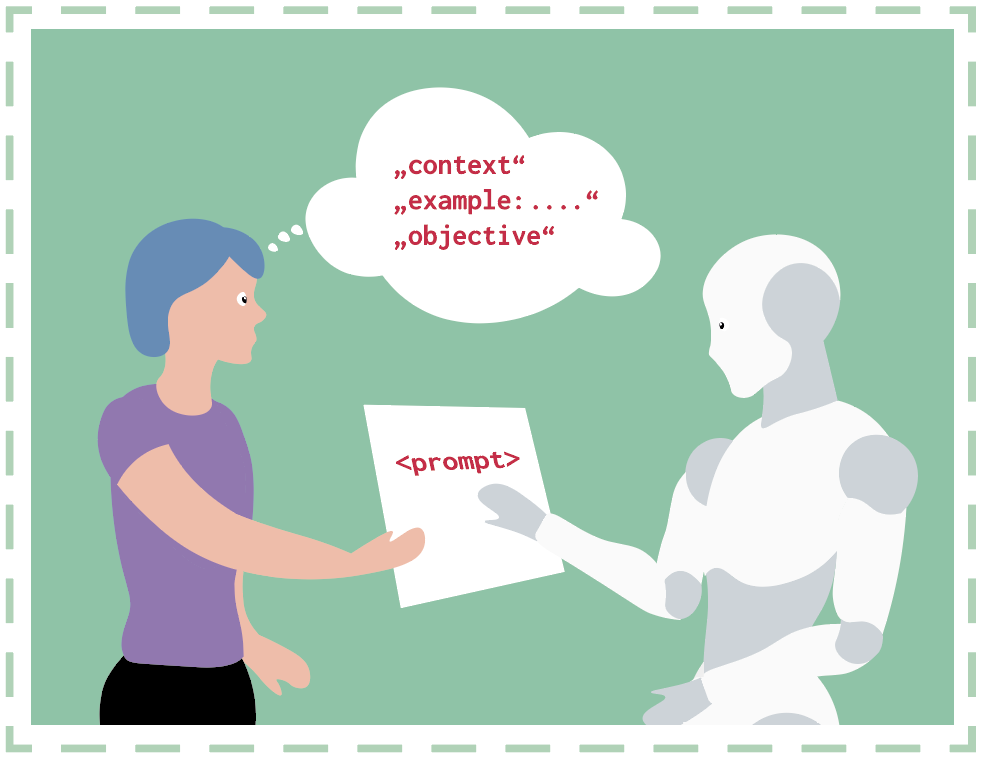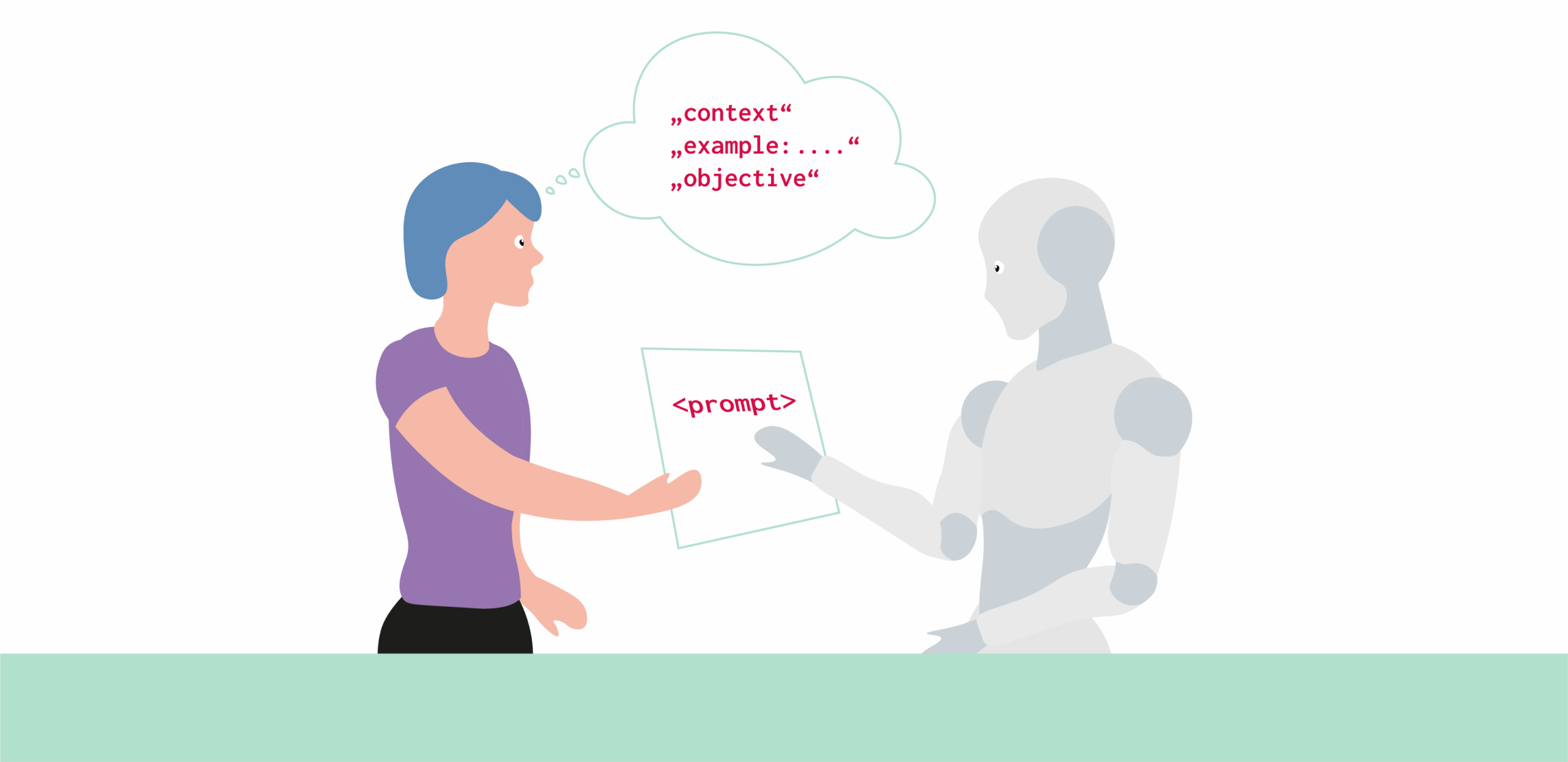#08 - Prompt Engineering in Teaching
Equipping students for constructive engagement with AI
Prompt engineering refers to the ability to formulate clear, targeted instructions (prompts) for AI systems in order to receive high-quality, helpful answers.
Students are going to work with AI systems during their studies and careers – to collect ideas or to structure complex content. Reflected use of such tools is a core digital skill, which is also illustrated by UNESCO's AI Competency Framework for Students.
This article shows several types of prompting techniques that your students can use.

The UNESCO AI Competency Framework for Students categorises AI skills into three levels:
- Understand
Understanding AI and how it works - Apply
Applying AI tools in a thoughtful and responsible way - Create
Creating and designing your own AI solutions
INTERACTIVE PLATFORM: prompting.schule
The platform prompting.schule by TU Graz is available for teachers and students (in German).
It offers interactive learning modules based on the levels 1. Understand and 2. Apply of the UNESCO competency framework and helps to learn the basic concepts of prompt engineering.

Teachers are invited to contribute prompting strategies in their domain – for example, mechanical engineering, architecture or biomedical engineering. More information on prompting.schule (in German).
PROMPTING TECHNIQUES IN TEACHING
The following prompting techniques, based on Schulhoff et al. (2024) can help students to get more differentiated and useful answers. The techniques are summarised in categories. For each category, an example of a prompting technique is presented and illustrated with an example prompt. Feel free to try out and modify the example prompts for your own subject area.
ZERO-SHOT
The AI does not receive an example, only a task.
EXAMPLE TECHNIQUE
Self-Ask
The AI asks follow-up questions in order to provide better answers.
EXAMPLE PROMPT
"I would like to create a lesson on the topic of data protection. Ask me 10 questions to better understand my problem."
FEW-SHOT
The AI receives a task, and additionally some examples (which may also be AI-generated).
Six main design decisions help choose good examples:
- Quantity: as many examples as possible
- Ordering: randomly ordered examples
- Balanced distribution: various types distributed evenly
- Quality: examples do not include mistakes
- Format: consistent and understandable format
- Similarity: examples matching the question
EXAMPLE TECHNIQUE
Vote-K
Examples are created by an AI and systematically selected.
EXAMPLE PROMPT
Prompt 1: "Explain the term 'algorithm' in 10 different ways."
Prompt 2: "Create a short, entertaining and informative video script using the following examples: (examples chosen from the first answer according to the six design decisions)"
THOUGHT GENERATION
The AI explains its thought process step by step.
EXAMPLE TECHNIQUE
Zero-Shot Chain of Thought
The AI is asked directly to illustrate its thought process step by step.
EXAMPLE PROMPT
"Here is some Python code that does not work correctly. Explain step by step what could be the reason."
DECOMPOSITION
Complex issues are broken down into sub-issues.
EXAMPLE TECHNIQUE
Plan-and-Solve
First, a plan is created, which is then carried out step by step.
EXAMPLE PROMPT
"Explain how the Bubble Sort algorithm works. First, create a plan. Name important learning goals and how an explanation has to be structured, then put your plan into action."
ENSEMBLING
Several prompts or answers are combined, for example by majority vote.
EXAMPLE TECHNIQUE
Self-Consistency
The same question is asked several times. The AI's answers vary slightly. In the end, the most common or most plausible solution counts.
EXAMPLE PROMPT
"Which data type should I use for a phone number?" (the same question is asked several times)
SELF-CRITICISM
The AI is made to scrutinise its own answer.
EXAMPLE TECHNIQUE
Chain-of-Verification (COVE)
The AI generates targeted questions to check its own answer, responds to them and uses these answers to edit the original answer.
EXAMPLE PROMPT
Prompt 1: "Which sorting algorithm is best suited for large amounts of unstructured data?"
Prompt 2: "Ask yourself critical questions on your answer, and answer them before editing your original answer."
CONCLUSION
Raising students' awareness of how to work with AI involves more than just teaching them how to use tools. Prompting is a door-opener for critical thinking, changing perspectives and creative approaches to solutions. By choosing to include prompting techniques in your teaching, you will enable your students to act competently, reflectively and in a future-oriented way in a world shaped by AI.


 TU Graz Educational Technology
TU Graz Educational Technology